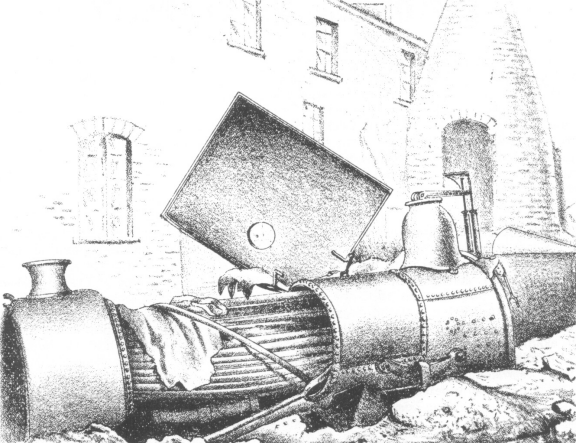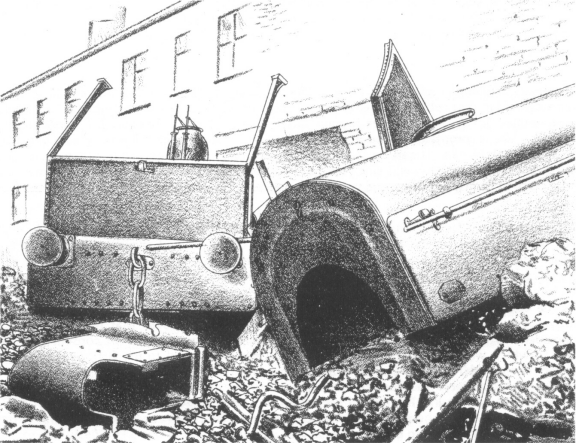
| THE INDUSTRIAL RAILWAY RECORD |
© APRIL 1973 |
EXPLOSION AT LLANELLY
"The .. subject of the present investigation was an 0−4−0 saddle tank made by Messrs. Black, Hawthorn & Co., of Gateshead, in the year 1873. In the same year it was delivered by Messrs. Hudswell, Clarke, & Co., of Leeds, to Mr. C.D. Phillips, then of Newport, Monmouthshire, where it was known by the name of 'Pallion'. ... The boiler was about 14 ft. in length. The barrel, which was 3 ft. 2 ins. in diameter, was made of three rings of plating originally 3/8 in. thick. The firebox was composed of copper. ... There were 80 brass tubes each 21/8 ins. in diameter. ... In the year 1882 the 'Pallion' was thoroughly overhauled and partially rebuilt by Messrs. Hudswell, Clarke, & Co., who supplied a new copper firebox and new tubes; and, on completion of the work, tested the boiler by water to 200 lbs., and by steam to 150 lbs. per sq. in. respectively."
"In the same year the locomotive was bought from Mr. Phillips by the Griff Colliery Company, Nuneaton, having been inspected, before purchase, by Mr. Andrew Mawbey, while undergoing the aforesaid repairs. It was then taken to the Griff Colliery, where it was worked at about 120 lbs. per sq. in., at which pressure it was able to draw a load of 75 tons on gradients of 1 in 40 or 1 in 30, and was known by the name of the "Swallow". In 1886 the engine was supplied with a new cylinder, and in 1888 the boiler was retubed. In 1894 it was thoroughly overhauled and almost rebuilt by Messrs. Bagnall, of the Castle Engine Works, Stafford... In 1898 the cylinder broke, and another was substituted in its place; but no further examination was made of the boiler after 1894. We were told that at the Griff Colliery Company the boiler was generally fed with rain water, but when there was a shortage of this, the feed was made up from water taken from the pit. The locomotive being found too light for. the work required of it, the Griff Colliery Company determined to sell it, and in November, 1901, a patch on the side, in the way of the longitudinal seam, having been fitted, owing to a leakage of steam, it was, in the same month, either sold to Messrs. J.H. Williams & Co., then Messrs. Williams, Cornforth, & Co., of Kidsgrove, or put in the hands of that firm for sale. Messrs. Williams having advertised it in their circular, received a letter dated the 20th November, 1901, from Messrs. Nevill, Druce, & Co., copper smelters, Llanelly, in the following terms:- "We notice in your list of machinery &c. received to-day a secondhand 12 in. 4 wheels coupled locomotive, Lot No.74, for sale. We are open to buy an engine of this type, and provided the price asked is strictly moderate, and the engine in fair condition, we are prepared to arrange to inspect her. We await your reply."
"To this Messrs. Williams replied as follows:- "We are obliged by the receipt of your letter to hand this morning, and can offer you subject to being unsold, one 12 in. saddle tank locomotive, four wheels, made by Black, Hawthorn, & Co., with copper firebox, brass tubes, 3 ft 1½ in. wheels, 6 ft. wheel base, working pressure 110 lbs. The locomotive was built in 1873, but this date is very misleading as a larger portion of this engine is completely new: It can be seen under steam, or at rest at the colliery where it is now lying. We shall be glad to hear that this will suit you; our price for it is £330 on rails. Please give one or two days notice before coming to inspect. Awaiting your reply."
"The works of Messrs. Nevill, Druce, & Co. are extensive. For the purpose of haulage they employ nine locomotives, and there are several stationary boilers, both Cornish and Lancashire, in use there. Of these and the other plant and machinery, Mr. David Bowen had charge. He has been with the firm for sixty years, commencing in the blacksmith's shop, he subsequently became foreman there, and finally rose to the position of foreman mechanic with a weekly wage of 45s. Mr. Richard Austin Nevill, the managing director, told us that he considered him to be a most careful and competent man, that he was an expert with regard to locomotives, having built many from drawings supplied; and moreover that hitherto there had never been any accident to the boilers or machinery over which he had control. ... In consequence of the correspondence to which we have just referred, Mr. Bowen was dispatched to the Griff Colliery at Nuneaton, where he was met by Mr. William Barker, manager for Messrs. Williams, and where he saw Mr. Mawbey, engineer to the Griff Colliery. Mr. Bowen found the "Swallow" in the colliery yard. He examined the firebox with a hammer, and found it in good condition. ... He was given a distance of about 100 yards in which to run the "Swallow", and with the assistance of its driver he tried it accordingly, but at what pressure he could not ascertain, as the steam pressure gauge was inoperative...


"On his return to Llanelly, Mr. Bowen reported ... that the "Swallow" was fit for the work of the firm. ... On Mr. Bowen's report, the "Swallow" was purchased. It was taken to Llanelly, where Mr. Bowen decided to work it at 90 lbs. per sq. in., a pressure sufficient for the work it had to do. ... After being worked eight or nine months, a leak developed in the bottom of the barrel in the first ring next the smokebox where there was a small crack. [Mr. James fitted a patch] over the defective part, and ... the working pressure was reduced to 80 lbs. per sq. in.
"On the 29th September [1903] Mr. James saw the "Swallow" in the locomotive shed early in the day; and about midday Mr. Bowen saw her on the line and ascertained that the patch put on [the boiler barrel] the day before was steam tight. On this day the "Swallow" was employed to do some truck hauling from the pottery works of Messrs. Guest & Dewsbury of Llanelly to the sidings of the Great Western Railway there. Two empty trucks, two trucks full of bricks and one van laden with pottery ware were to be moved, their weight being in all 39 tons 6 cwt. John Roberts was the driver in charge; and Daniel Davies the stoker and shunter. We were told by Thomas Joseph Davies, a brick-maker, employed at the pottery, that he advised that only one half of the load should be taken at one time, but that after some shunting, the trucks not all being on the same section of the line, Roberts took the whole load. Having coupled the trucks together he sanded the lines and attempted a start, proceeded about 2 feet, and then returned and started again, when, just after moving, a chain that attached two of the trucks snapped, and Mr. Davies went home.
"About 6 p.m. John Roberts, a potter, was on one side of an arch on the works, and the "Swallow" just under it or a very short distance from where she had started. Roberts watched her for five or six minutes, during which time she was stationary, and at the end of that time an explosion occurred. David Davies, a muffler boy, saw Roberts, the engine driver, working the lever backwards and forwards, and afterwards observed that the wheels of the "Swallow" were off the line and the buffer against a wall. He heard Roberts crying for help, and found that he was caught by the trousers by the springs over one of the wheels; from which position he was released by some person, but was found to be very badly scalded. He saw Davies, the stoker, lying dead close at hand. Roberts was taken to the infirmary, where he died on the 1st October. ... The explosion was a violent one. The saddle tank was lifted bodily and thrown sideways about ten yards. The plate at first ruptured at the lap of a longitudinal seam in the centre ring of the barrel. This ring together with the one nearest the smokebox were completely torn out and projected to one side. A number of the tubes were bent and broken, while the engine framing was distorted. ... The explosion was due to grooving of the barrel plate at a longitudinal seam weakened by excessive pitting, so that the barrel could not resist the steam pressure."
(The information above has been extracted from Boiler Explosion Report No. 1485, issued by the Board of Trade.
— KPP)LEEDS FORGE CO LTD. - "After a continued succession of delays beyond the company's control, the directors have at last succeeded in obtaining the construction by the Midland Railway Company of a branch connection to their main line. The benefits from this connection in the transport of the inward and outward traffic did not come into working operation until the close of 1891."
("Iron," 11th March 1892.
— KPP)'The Silkstone and Haigh Moor Collieries, Limited. — a regularly daily sale is maintained of upwards of three hundred tons from the Leeds wharves alone, while a service of some thirty or forty boats convey the coals from the pits at Allerton Bywater, Castleford ... The collieries have direct water communication by means of the Aire and Calder Navigation. The extensive and valuable plant includes three powerful locomotives, several miles of sidings, and a complete system of screening apparatus by machinery . . .' (From "The Century's Progress: Yorkshire" published in 1893.
— KPP)'Second-hand Contractor's Engine WANTED for 5ft. 2in. Gauge Railway. - State price and full particulars to "ENGINE," POTTLE AND SON, Royal Exchange, E.C.' ("Iron," 17th June 1876. The gauge quoted is of an unusual size and may well be a misprint. Comments invited.
— KPP)